Ron Ludekens
Snow Fountains Fall Color
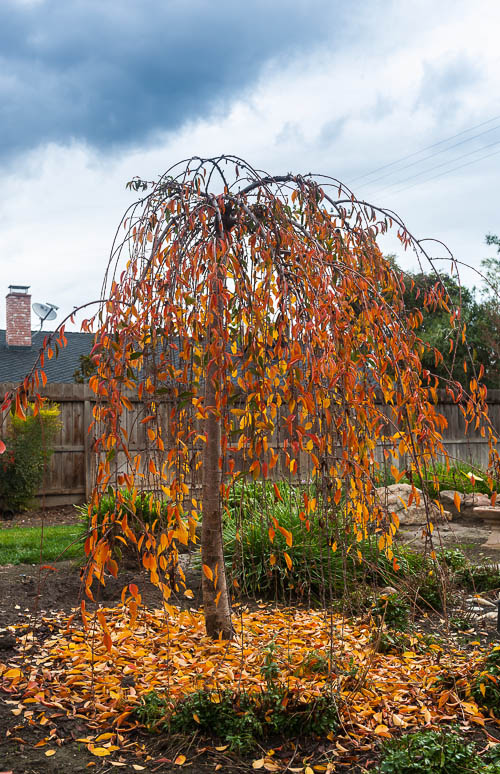
Snow Fountains® Flowering Cherry Fall Color
Autumn is one of my favorite times of the year. I am sure it is for you too. As a photographer, I enjoy seeking out the bold colors of the season and often don't have to go far to find them. This photo taken last week is what my wife and I get to see right outside our kitchen window. I decided to snap this photo just as the rains began - knowing that the storm would finish knocking down the leaves and ending the show.
We have 3 Snow Fountains® Flowering Cherries in our yard. So I guess you can say I like them. The one out front is a 30" specimen that looks great among the landscape boulders. The one in this photo is a top grafted selection which is more common in the trade. I found our new dog loves lying under the shade it creates during the hot summer days. The other one in our side yard is a low budded selection that was rasied up to 6 feet with weeping branches the whole height. It is spectacular and one that more people need to plant in their yards.
If you want to see the stunning white spring blooms, take a look at my earlier blog: http://www.lecooke.com/cms/component/content/article/43-flowering-trees/366-snow-fountains-flowering-cherry.html
Additional gallery of photos can be seen here: http://www.creatorspalette.com/FloweringFruitTrees/Flowering-Cherries/Snow-Fountains-Weeping/
Since the leaves are falling, it means bareroot harvest is upon us. Won't be long before we are shipping trees to our customers.
Ron Ludekens 12-6-2012
Something's Going On By The Water Coolor
(Drying Hachiya Persimmons)
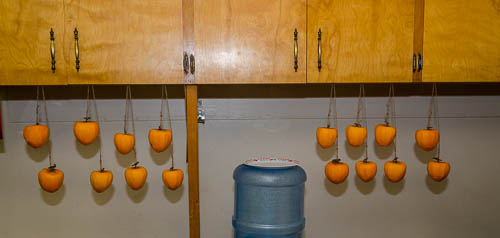
Hanging Around By The Water Cooler
We had read about dried persimmons (Ancient Art of Hoshigaki) in various articles (example here and here) but most of the office and sales staff had never tried them. This week, James brought in some dried Hachiya Persimmons and we were pleasantly surprised at the flavor and sweetness.
Now James is showing us all how to dry the Hachiya Persimmons. With the help of Lloyd, the persimmons were "topped", peeled (skinned) and tied up to dry in the company kitchen.
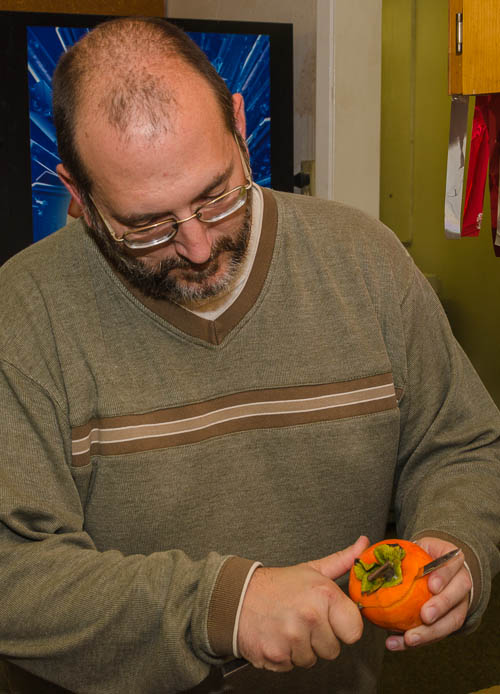
Lloyd "topping" the Hachiya Persimmon but leaving the stem for hanging.
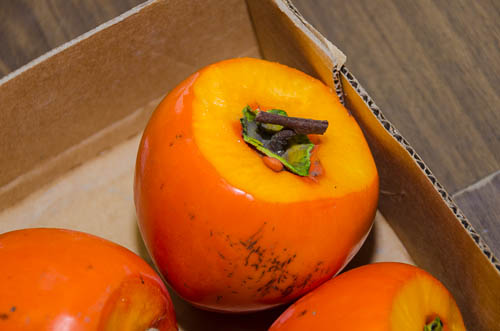
"Topped" Persimmons
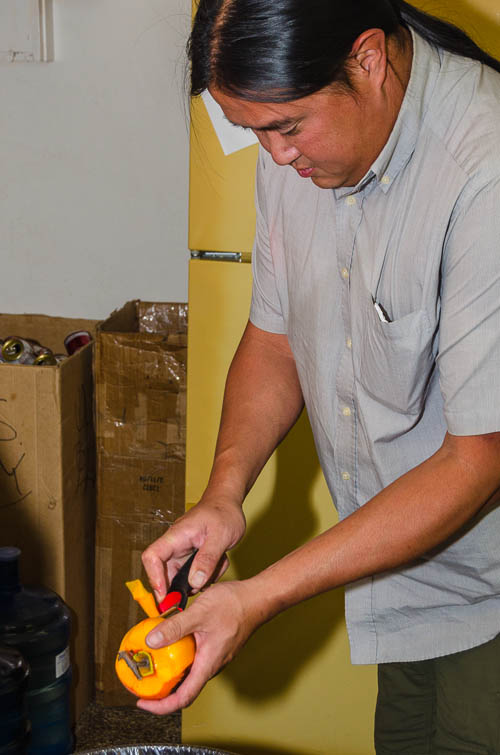
James is peeling the Hachiya Persimons
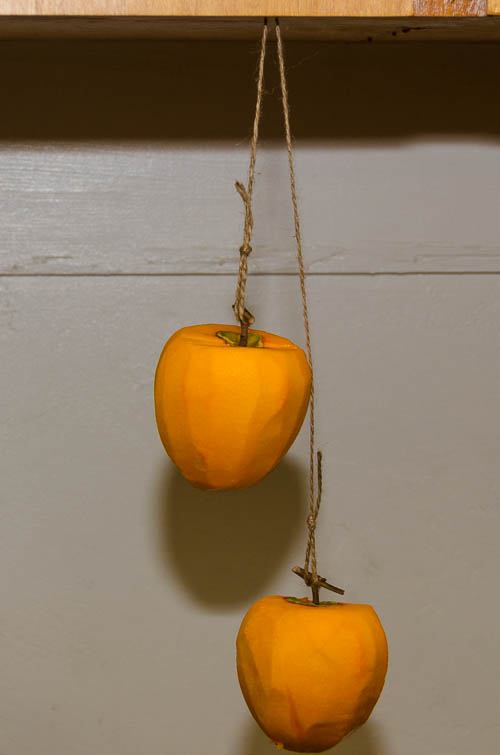
Next they are tied to string in preparatin for hanging out to dry.
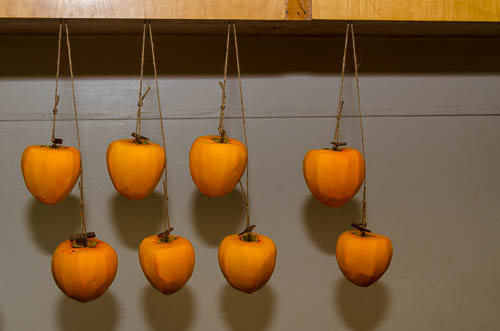
Hachiya Persimmons hanging in the office kitchen under the storage cabinets.
In about four weeks we will see and taste the fruits of their labor. Lloyd suggested we go into production of dried persimmons as they are currently selling in some markets at $9-$15 a pound. Hmmm....sounds like a good project for the grandkids to earn their college funds.
Ron Ludekens 12-5-2012
YouTube Videos by L.E. Cooke
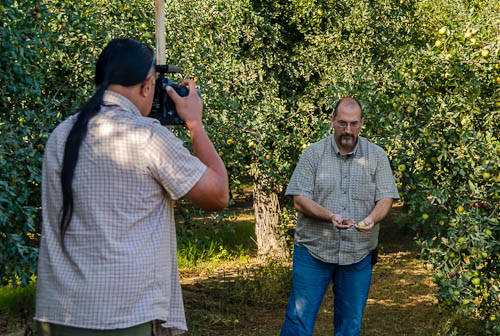
James is video recording a session with Lloyd for the LEC YouTube Channel.
This one is being taken in the Jujubes.
This summer our enterprising and multi-talented sales staff took some time out of their busy sales trip schedules to create informative videos for our customers to use. Lloyd Cassidy has been the on-camera "host" for most of these sessions. James Shao has been the videographer. Ernie Adamakis has been the editor, director and driving force to get them completed and posted to YouTube. The rest of us have been the gofers, grips and occasional but good humored critics. I am thrilled that all this good stuff is getting done without me having to do anything but applaud.
They have a whole host of ideas to turn into videos which we hope will be of help to our customers and your customers. As we get better at it, I am sure we will re-do a few to polish them up. All our videos are very short - under 4 minutes each.
Here is the main Link to the L.E. Cooke YouTube Videos: http://www.youtube.com/user/LECookeNursery
What do we have and have planned?
First up are the educational series related to handling bareroot. 1) Introduction to Bareroot, 2) Delivery Day Unloading, 3) Delivery Day Storage, 4) Bareroot Display Box, 5) Canning Bareroot, 6) Why Prune?, 7) Pruning Pomegranates for Transplant Survival, 9) EZ-Pick?, 11) Bareroot Grapes. Handling bareroot is an area needing constant training and re-training in the nursery industry.
Their goal with these instructional videos are to help you and your staff be very successful with handling and selling bareroot trees. There are more to come that are still in editing (as you can see by the missing numbers).
They also have been shooting scenes by the fruit trees as the fruit ripens and talking about why they like it. I think the fruit is ripening and video being shot faster that we have time to edit and publish the end results. Check back frequently for more.
I suggest you "Like" us on our Facebook Page and as new videos are created, we will let you know through the Facebook page.
Email us and let us know what you would like to see in videos.
Thank you
Ron Ludekens 9-19-2012
Kelsey Plum
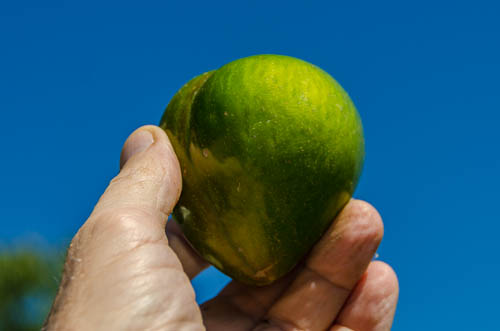
Kelsey Plum - attractive with bloom rubbed off (photo 8-8-2012)
Took a stroll through the orchard this morning before the blazing heat made it intolerable. Came across the Kelsey Plum with some ready to pick.
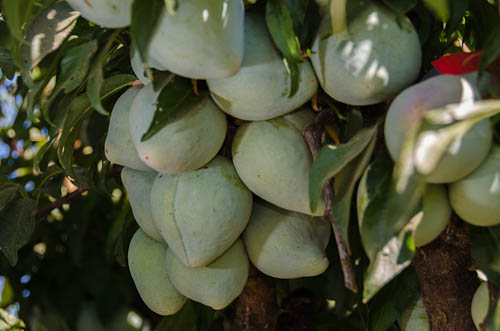
Kelsey Plum Tree - Loaded with fruit
This is no ordinary Japanese Plum. Color, shape and most importantly taste make it stand out. The unique bright green heart shape is what everyone first remembers about this variety - at least until they bite into it and discover the very sweet, juicy, rich flavor. Flesh is amber, sometimes blushed red on the sunny side. We shared with the office staff and won over some more fans.
Kelsey Plum was put back in our catalog this year based upon customer requests. It will need a pollinizer such as Santa Rosa, Beauty or Wickson Plum. It ripens early to mid August in the Central Valley of California and it is right on time. Cold hardy to USDA Zone 5. Information PDF Page here
Ron Ludekens 8-18-2012
The Amazing Burgundy Plums
I took a quick walk today to the orchard to document some ripening times of the apricots (camera in hand of course) and ran across one of my favorite plums already ready to pick.
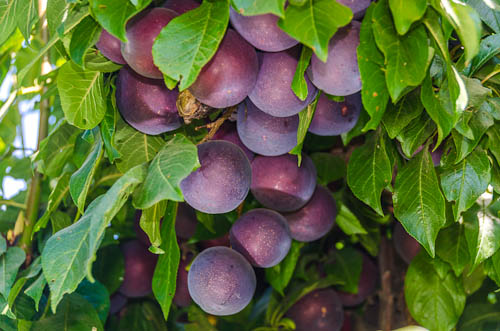
Please note that it is July 3rd and summer has been kind to us so most orchard fruit crops are a little behind normal.
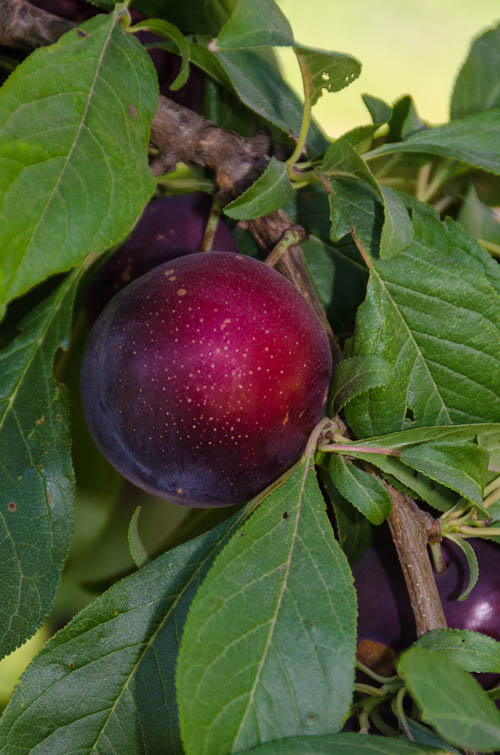
What is amazing to me is that we will be still eating quailty fruit off this tree in late August or even early September!
This is a red fleshed Japanese Plum ranking with the best like Satsuma and Mariposa. What makes this variety special is it does not need a pollinizer - it is self fertile!
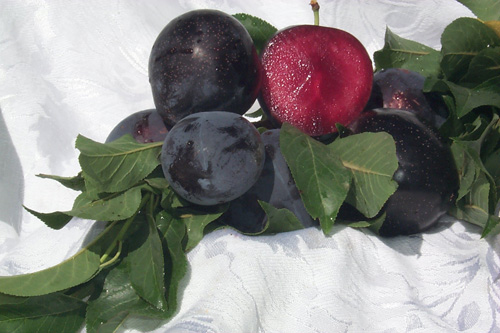
Four years ago, I started covering a sales territory in central Texas. I was surprised to find that their normal palette of plums was Santa Rosa and Methley. Nothing wrong with those great selections. But in my mind, all retail nurseries should offer at least one Amber fleshed plum (often Santa Rosa is one of these choices) AND at least one red fleshed plum (typically Burgundy). So I twisted a few arms at some of the greatest nurseries in Texas to try some Burgundy. Since then, the customer feedback has been amazing and Burgundy sales have taken off!
Are you offering your customers the choice of red fleshed and amber fleshed plums? (Don't forget a third choice of green fleshed plums as well).
Yummm - plums all summer!
Ron Ludekens 7-3-2012
Top Blueberry Varieties Chosen
Grow Produce just posted this article about blueberry evaluations in California:
Top Blueberry Varieties Chosen - GrowProduce.com
We have visited these test blocks at the Kearney Field Station many times over the years and our selections for the Southern Highbush varieties for the warmer winter and hotter climate areas reflect our discoveries from these trials. I am happy we are in agreement with their findings! Of course, test plots in more northern climates will have different choices.
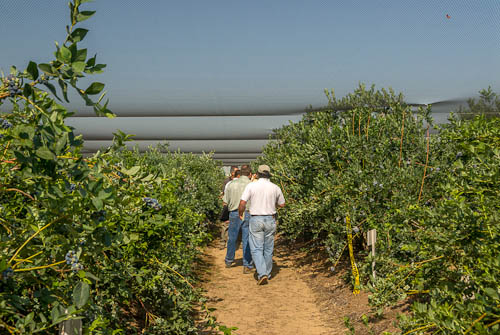
By the way - it is a delight to participate in these taste tests!
Ron Ludekens 5-30-2012
In case the link gets broken in the future, the article is repeated below:
Top Blueberry Varieties Chosen
In California tasting, Southmoon variety rated tops in taste.
May 29, 2012 – FROM WWW.GROWPRODUCE.COM
Blueberry evaluation in California
The favorite blueberry varieties rated by 56 taste testers in California’s San Joaquin Valley for 2012 include Southmoon, Reveille, Biloxi, and Legacy. Following the top four were Jewel, Sharpblue, Misty, and Star. Most are Southern Highbush varieties, but some Northern Highbush varieties were also rated highly.
The organizer of the tasting, University of California (UC) Cooperative Extension Small Farms Advisor Richard H. Molinar, said it’s important to remember that taste tests are subjective, and that everyone has their own preferences. Some prefer sweet, some more acidic or tart. Other criteria that determine preferences include aroma, such as citrusy or floral, crunchiness, size, softness, stems attached, and appearance. “There is no right or wrong answer,” said Molinar, “but we do see trends.”
Flavor is of course affected dramatically by variety. Of the 62 varieties planted at the UC Kearney Research and Extension Center in Parlier by Manuel Jimenez, farm advisor for Tulare County, 11 were available to sample at the May 23 Blueberry Field Day. Flavor is also affected by weather, soil factors, plant nutrition, and irrigation frequency. An exceptionally good tasting variety one year might be only mediocre the next.
According to Molinar, “when we first started this project 14 years ago, some of the recommended varieties for the San Joaquin Valley included Reveille and Georgia Gem. Then came Star, Oneal, and Misty as good choices. Now Emerald, Jewel, and Springhigh are the new kids on the block, along with Snowchaser. It doesn’t mean they are the best tasting. They might be higher yielding, ripen at a certain time, are more disease resistant, or have better postharvest quality, etc.”
Molinar said so many varieties are desirable because there are differences in when they ripen, flavor, or yield. Adaptation to a particular region or soil, shelf-life, adaptation to mechanical harvesting, and offering something new to buyers are all reasons for the different varieties. Growers might start picking May 15 with Snowchaser, and end with Centurion, a rabbit eye variety, in July. Molinar adds that his favorite variety has not changed for 10 years; it is still Southmoon. And is there agreement in the family? No, his wife prefers Sharpblue.
But do you ever see the variety names listed on the clam shells in the store? “Not usually,” says Molinar. “Oftentimes the varieties are mixed together at the packing facility, or the variety is just not named. How many times do you go to the store and just see white peaches, or seedless personal watermelons, or strawberries? There are over 50 different white peaches grown in the valley. Buy locally from a roadside stand and chances are better you can find out the variety name.”
Source: Richard H. Molinar, University of California Cooperative Extension Small Farms Advisor
Smoke Tree Question
Question: Hi there,
I love the purple smoke tree and am wondering if it would do well in a planter in full sun (in San Diego)? And if it's deciduous? How tall and wide do you think it would actually get in a planter?
Thanks so much!
Shoshanah - San Diego
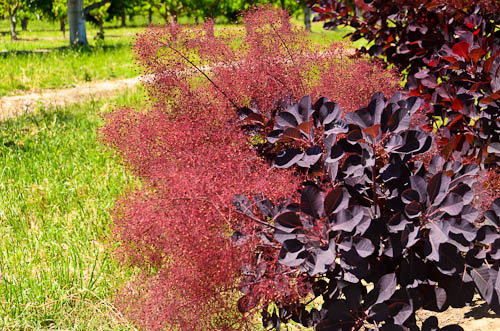
Cooke's Purple Smoke Tree Bloom
Answer: I find the Purple Smoke Tree very attractive as well. It is also very drought tolerant and requires very little water - making it a popular selection for xeriscape projects where a strong accent plant/tree is desired.
The smoke tree is not a small plant. If left to grow un-pruned in the ground it can reach sizes approaching 15-20 feet high and wide. You need to take this into consideration in selecting your location and BIG pot/planter. Of course pruning can keep it smaller, but remember, over time the trunk will become substantial even if the tops are kept shorter.
Because it is a desert loving plant, you need to take care in what it is planted and how it is watered. The soil/media needs to drain very well as this plant/tree will not like wet feet. So be very careful how much organic potting mix you put in the pot or add to the planter/ground. Add more coarse river/cement sand. It does require sun and will go dormant in the winter. We used to have a large one on the north side of our office (before the office expansion) and it looked nice with partial shade but they thrive in our desert-like summer heat in full sun.
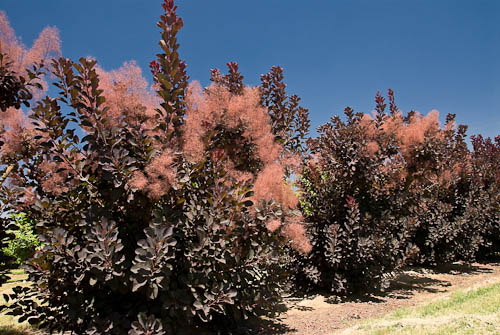
Cooke's Purple Smoke Tree in Scion Wood Orchard
More information here: LEC Information Pages
More Photos Here: www.CreatorsPalette.com
Ron Ludekens 5-30-3012
Vitex agnus-castus sources
Question: I found Vitex for sale on the Internet in seed form but cannot seem to locate a local store. I can work with seeds but would rather have an established plant. Can you help me find a store to purchase this awesome plant from?
Kind regards,
Lisa - Southlake, Texas
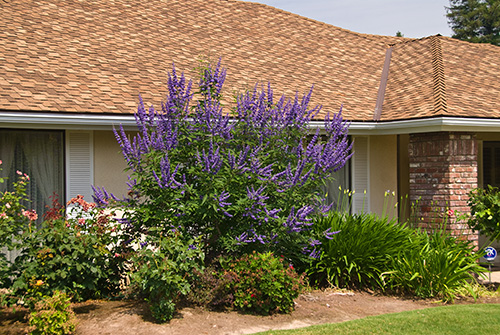
Purple Vitex agnus-castus in the landscape
Answer:
I just returned from a three week sales trip through central Texas and after your severe 2011 drought, the Vitex is one of the hot products because it handles drought so well and looks very nice in the landscape. Almost every independent retail nursery (but maybe not box stores) should carry it so pick up your yellow pages and call local nurseries. Most retail nurseries will not list their thousands of products on the Internet unless they are also doing mail order so an internet search will mostly only get the mail order firms. Phone still works very well.
Vitex from seed is very possible except those plants will vary slightly in color, shape and growth habit. We selected some nice colors (Pink, White, Blue & Purple) from seedlings over many years and now grow them clonally so every plant is the same as the original. There are some other named selections in the industry that are also very nice. Vitex can grow in most climates - but the blooming season lasts longer in the hotter climates - opposite of most blooming plants/trees. Link to more Information and photos.
Hope you find what you are looking for.
Ron Ludekens 5-29-2012
Why Some Retailers are Doing Poorly
I wanted to write this last year at this time but did not have the guts. Now that I am seeing it again, it is time to say something.
Some retail nurseries need to take a hard look at themselves as they are the cause of their own failure.
Last year in April-May I did a 3 week Texas sales trip covering from Laredo, through San Antonio, Hill Country, Austin and Dallas-Fort Worth Metroplex. Last year most every retail nursery had a great spring with records in March and many had record April sales until the drought slowed things down a bunch. Three nurseries stood out in all my visits (approximately 120 nurseries visited) because they had very poor springs. It was so contrary to what everyone around them was experiencing. All blamed the poor economy, government interference and a host of other things.
As I write this, I am again doing a similar 3 week trip and already have visited over 80 nurseries. Again, in spite of last year's horrendous drought and current dought fears, retail sales have been very good with most being within 10-20% of last year's record sales. Two nurseries stand out as having had very poor spring sales. I expect tomorrow I will see the third if the owner has not changed anything from last year.
The poorly performing nurseries stand out because all three have no reason for a customer to come in to the nursery. There are no blooming flowers out front and no edibles (fruit trees, grapes, berries, vegetables, etc) available to sell. They are stocked with green foundation shrubs and perennials and pottery.
Nurseries sell products that make you feel good. We cater to a person's aesthetics and emotions. We are the suppliers of art for the landscape and delicious, sweet flavors for the taste buds. Edibles have been one of the hot spots in retail nursery sales for 4-5 years now. If you don't have displays of attractive color and edibles you have missed the boat.
Here is another observation from my Texas travels. The population seems to be expanding at a rapid rate into the Hill Country to the west of San Antonio and Austin. On the surface, this seems odd. The winters are colder, the ground is a lot of rock and very difficult to landscape. On the other sides of these cities it would be a lot easier to build homes and plant gardens or landscapes. So why is the population shifting to the Hill Country? I am guessing it is the beauty of the wildflowers in the spring. It is incomparable and one of the reasons I love doing this sales trip at this time of year.
If a homeowner is willing to move to the rocks to see spring wildflowers, I suggest nurseries make sure their display of spring blooms is just as outstanding so customers come through your doors.
Ron Ludekens 5-12-2012
Where are the Red Trucks?
"Where are the Red Trucks?" Answer: We are going "Green"
No, not green trucks. Something a whole lot more fuel efficient and cost efficient. Hybrid cars.

I guess being in the "Green Industry", I get a little jaded about all the "Going Green" topics in the press. So forgive me if I write about something similar on this blog.
Those of us in agriculture are constantly working to be efficient, to conserve and to be "sustainable". You do not grow on the same dirt very long before you realize that non-sustainable practices will kill that dirt and make it non-productive. So over the years, we "farmers" learn a thing or two about sustainability. As technology improves and becomes affordable, we look for ways to improve our practices. One area we have made huge strides is with water conservation, air quality, tractor diesel fuel reduction, labor reduction all while improving the quality of the trees - which all came through long research into drip irrigation methods. That is a story for another blog.
If you have been our customer for very long, you came to immediately recognize our red 3/4 ton, F250 Ford pickups. For decades, these have been our sales vehicles and often delivery vehicles. We had the red trucks even before red became a popular color. In the early days we had to custom order them for the color. Once we retired the trucks from sales use (about 200,000 miles), they worked on the nursery ranches in production.
About 20 years ago, we began the discussion of doing something more fuel efficient but there were a number of obstacles to overcome. Many of those obstacles were eliminated in the course of the inevitable changes that happen around us. Here are some of the uses we discontinued:
We used to use these trucks with big custom built bodies on them to make the smaller order deliveries to customers in California. Over time, it became apparent that the 24' diesel bobtails were nearly as fuel efficient as the gas guzzling pickups with ungainly big boxes. And fewer drivers were needed. We burned up a few transmissions (and one truck) when the overdrive was not turned off so shipping via pickup was reduced. When the CHP (California Highway Patrol) told us the custom big boxes were not approved for the trucks, we stopped all together. Now all deliveries are on the bobtails or larger rigs.
Sales staff used to return trees and soil samples to review to discover the causes of any tree losses. That needed the trucks. We discontinued that practice the year Sudden Oak Death started to appear in other areas of the country. We no longer wanted to run the risk of returning anything that could bring disease or pests into the area or the nursery. This became one of the many "Best Management Practices" we put into place to keep a clean nursery environment. We are very strict on purchases of liners by their source and prefer to grow and try to grow all our own stock from the beginning so as not to import any pest or disease from others.
As a courtesy to our customers, the sales staff often made small deliveries (below minimum) to their customers during the January-February follow-up season. Unless it now fits in the trunk or back seat (ie berry plants), we have had to discontinue that practice. Sorry.
Last year the fuel costs rose again and after a few sales trips in the trucks, we realized that we could lease a car for a week (with fuel costs) for the same amount it costs just to fuel the pickups! And since it was about time to buy some more pickups, we decided to try leasing for the rest of the year. This year, we made a special request from the car rental company to see if they could obtain hybrids for us and they did!
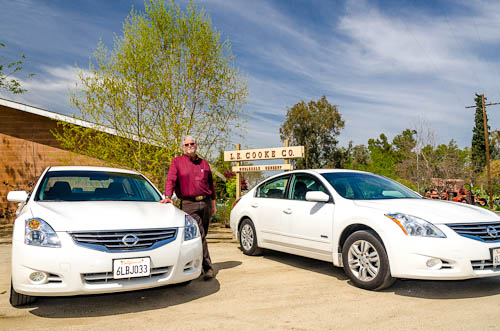
G.M David Cox standing next to two of the three Hybrid cars used for sales staff.
One problem I had - I could not figure out why the car would not start until I was told it was already running and just super quiet  . And they are not red.
. And they are not red.
This is not a dramatic change and many of you have done it long before, but it is one of many minor changes that add up over time to being better stewards of things we have control over.
Ron Ludekens 4-10-2012


